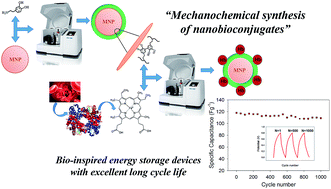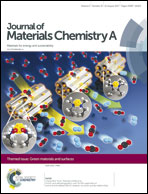Mechanochemical design of hemoglobin-functionalised magnetic nanomaterials for energy storage devices†
Abstract
A bio-modified nanomaterial based on horse hemoglobin (Hb) and cobalt oxide magnetic nanoparticles (Co3O4 MNPs) was synthesized using a simple solventless mechanochemical dry milling step. Dopamine (DA) was employed as a robust scaffold to design the stable nanostructures. The nitrogen band (400 eV) in the XPS spectrum, together with zeta potential measurements, supports the presence of Hb in the obtained nanostructure. Additionally, the amide I and amide II bands at 1654 cm−1 and 1545 cm−1 in the FT-IR spectrum suggest that Hb does not undergo changes in its secondary structure. This assumption was also confirmed by Resonance Raman spectroscopy. TEM images reveal a homogeneous distribution of the Hb–DA–Co3O4, with a particle diameter of 10.1 ± 0.2 nm. The functionalised materials exhibited a relevant magnetism, preserved upon functionalisation. The functionalised Hb–DA–Co3O4 nanocomposite was successfully employed in the design of a supercapacitor (specific capacitance average: 115 F g−1) with excellent cycling durability, with over 94% specific capacitance retained after 1000 cycles.

- This article is part of the themed collection: Green Materials and Surfaces


 Please wait while we load your content...
Please wait while we load your content...